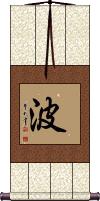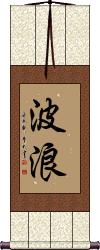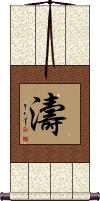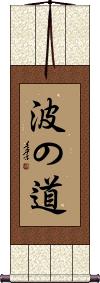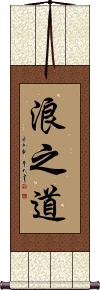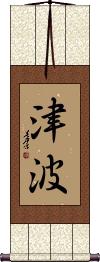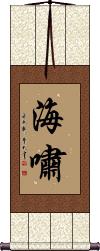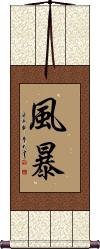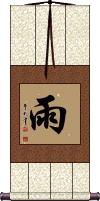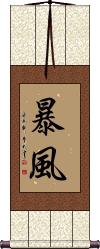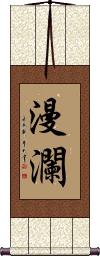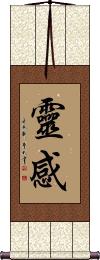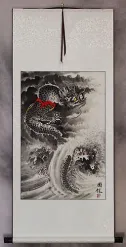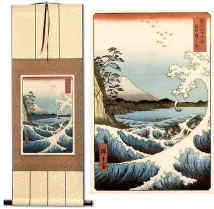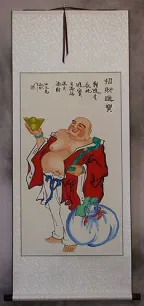Many custom options...
And formats...

Wave in Chinese / Japanese...
Buy a Wave calligraphy wall scroll here!
Personalize your custom “Wave” project by clicking the button next to your favorite “Wave” title below...
Wave
波 is the most simple way to express wave in Chinese, Japanese Kanji, and Korean Hanja.
This single character means wave. In Japanese, this is pronounced “nami” which is the same “nami” as used in the word “tsunami” (harbor wave).
Wave
If you like to ride a surfboard, and/or “The Way of the Wave” is your life, 波浪 could be the scroll for you.
The additional meanings contained in these characters include ripple, storm, surge, breaker, wandering, and unrestrained.
Big Wave
濤 is the Chinese character for “Big Wave.”
It suggests a wave unlike most, strong and powerful.
濤 is technically also a Japanese Kanji, and Korean Hanja but it's not commonly used in those Asian languages. Pronunciation in Japanese and Korean is provided above for reference only. Just order this if your audience is Chinese.
The Way of the Wave
波の道 is the simple way to write “The Way of the Wave” in Japanese.
I added this at the request of several customers. 波の道 is not a very common Japanese phrase.
波 = Wave
の = Of
道 = Way
The word order is the opposite of English. Most Japanese phrases that end in “の道” are translated to English as “The Way of...”
Technically, you could write “波道” as a shorter version of “The Way of the Wave.” However, without context, 波道 can mean channel or suggest a path to redirect ocean flow.
The Way of the Wave
The Tao of the Waves
Tsunami / Tidal Wave
Tsunami / Tidal Wave
Tsunami / Tidal Wave
Storm
風暴 is the Chinese word for storm.
If the meaning of storm is somehow important or significant to you, these are the characters you want.
The first character means wind, and the second means violent or sudden.
Note: This would be understood in Korean Hanja, however, Koreans would generally use these characters in reverse order.
See Also: Rain
Rain
Storm / Windstorm
Best for Japanese audience
暴風 is the Japanese Kanji and old Korean Hanja word for storm (can also mean gale, tempest, typhoon, hurricane, gale, violent wind, or windstorm - especially in Korean and Chinese).
If the meaning of storm is somehow significant to you, these are the Kanji you want.
The first Kanji means violent or sudden. The second Kanji means wind.
This also means storm in Chinese but more in regards to a wind storm than a general storm. It's about the same for this word in Korean.
Carry On, Undaunted
前赴後繼 is a Chinese proverb that figuratively means “to advance dauntlessly in wave upon wave.”
It suggests that you should or can carry on and have the strength to keep going.
While this proverb is a little bit militaristic, it suggests that despite a fallen comrade (or perhaps a loved one), you should keep going and work towards the goal they intended.
Beau
This is a common transliteration to Mandarin Chinese for the name Beau.
This Chinese character means “wave.”
No Limitations
漫瀾 is the Chinese, Japanese Kanji, and old Korean Hanja for “Having no boundaries or limitations.”
This literally talks of the vastness of an ocean or river.
Character breakdown:
漫 = free; unrestrained; to inundate; overflowing; boundless.
澜 = swelling water; large wave.
Chung Do Kwan
靑濤館 is the Korean martial arts style, Chung Do Kwan, meaning “Blue Wave School.”
If you want this in modern Korean Hangul characters, click on the Hangul next to the Korean flag above instead of the button above.
Also Romanized as “Cheong Do Gwan” or “Ch'ŏng Do Kwan.”
Inspiration
靈感 is the Chinese word closest to hitting the mark for the English word inspiration.
In a more extended context, I have even seen this translated as “brain wave.”
The first character means alert, departed soul, efficacious, quick, effective, or intelligent.
The second character means to feel, to move, to touch, or to affect.
The combined meaning of these two characters changes a bit, but I think it's nice to know the individual meanings to give you a better understanding of where a word comes from.
You could describe this word as “the thought that pops into your head just before you patent the greatest widget ever invented that everyone in the world will want.”
At least, that's the idea.
This term can also mean “intelligent thought” if you translate it directly from each character. If you are looking for inspiration or need to be inspired, this is the word for you.
![]() When the first character was absorbed into Japanese from Chinese, an alternate form became the standard in Japan. The Kanji shown to the right is the form currently used in Japan. This is still considered an alternate form in China to this day.
it’s
readable by both Chinese and Japanese people but if your audience is Japanese, I recommend the Kanji shown to the right - just click on that Kanji to order that version.
When the first character was absorbed into Japanese from Chinese, an alternate form became the standard in Japan. The Kanji shown to the right is the form currently used in Japan. This is still considered an alternate form in China to this day.
it’s
readable by both Chinese and Japanese people but if your audience is Japanese, I recommend the Kanji shown to the right - just click on that Kanji to order that version.
This in-stock artwork might be what you are looking for, and ships right away...
Gallery Price: $108.00
Your Price: $59.88
The following table may be helpful for those studying Chinese or Japanese...
| Title | Characters | Romaji (Romanized Japanese) | Various forms of Romanized Chinese | |
| Wave | 波 | nami | bō / bo1 / bo | po |
| Wave | 波浪 | harou / haro | bō làng / bo1 lang4 / bo lang / bolang | po lang / polang |
| Big Wave | 濤 涛 | nami | tāo / tao1 / tao | t`ao / tao |
| The Way of the Wave | 波の道 | nami no michi naminomichi | ||
| The Way of the Wave | 浪之道 | làng zhī dào lang4 zhi1 dao4 lang zhi dao langzhidao | lang chih tao langchihtao |
|
| Tsunami Tidal Wave | 津波 | tsunami | ||
| Tsunami Tidal Wave | 海嘯 海啸 | tsunami | hǎi xiào / hai3 xiao4 / hai xiao / haixiao | hai hsiao / haihsiao |
| Tsunami Tidal Wave | 津浪 | tsunami | jīn làng / jin1 lang4 / jin lang / jinlang | chin lang / chinlang |
| Storm | 風暴 风暴 | fēng bào / feng1 bao4 / feng bao / fengbao | feng pao / fengpao | |
| Rain | 雨 | ame | yǔ / yu3 / yu | yü |
| Storm Windstorm | 暴風 暴风 | baku fuu / bou fuu / arashi baku fu / bo fu / arashi | bào fēng / bao4 feng1 / bao feng / baofeng | pao feng / paofeng |
| Carry On, Undaunted | 前赴後繼 前赴后继 | qián fù hòu jì qian2 fu4 hou4 ji4 qian fu hou ji qianfuhouji | ch`ien fu hou chi chienfuhouchi chien fu hou chi |
|
| Beau | 波 | bō / bo1 / bo | po | |
| No Limitations | 漫瀾 漫澜 | man ran / manran | màn lán / man4 lan2 / man lan / manlan | |
| Chung Do Kwan | 靑濤館 | qīng tāo quǎn qing1 tao1 quan3 qing tao quan qingtaoquan | ch`ing t`ao ch`üan chingtaochüan ching tao chüan |
|
| Inspiration | 靈感 灵感 | reikan | líng gǎn / ling2 gan3 / ling gan / linggan | ling kan / lingkan |
| In some entries above you will see that characters have different versions above and below a line. In these cases, the characters above the line are Traditional Chinese, while the ones below are Simplified Chinese. | ||||
Successful Chinese Character and Japanese Kanji calligraphy searches within the last few hours...
